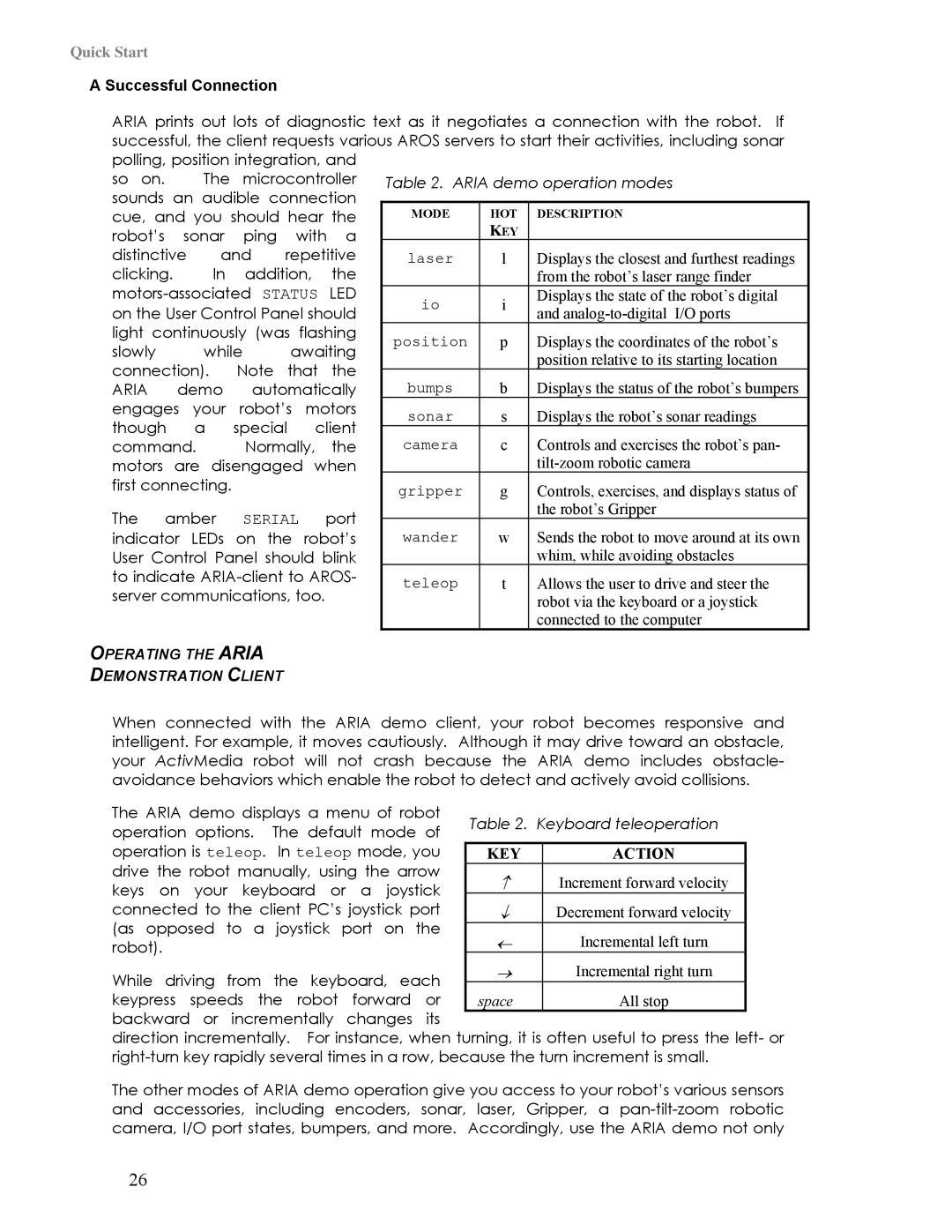
Quick Start
A Successful Connection
ARIA prints out lots of diagnostic text as it negotiates a connection with the robot. If successful, the client requests various AROS servers to start their activities, including sonar polling, position integration, and
so on. The microcontroller sounds an audible connection
cue, and you should hear the | MODE | HOT | DESCRIPTION | ||||||
robot’s sonar ping with a |
| KEY |
| ||||||
|
|
| |||||||
distinctive | and | repetitive | laser | l | Displays the closest and furthest readings | ||||
clicking. | In | addition, | the |
|
| from the robot’s laser range finder | |||
io | i | Displays the state of the robot’s digital | |||||||
on the User Control Panel should | and | ||||||||
light continuously | (was flashing | position | p | Displays the coordinates of the robot’s | |||||
slowly |
| while | awaiting | ||||||
connection). Note that the |
|
| position relative to its starting location | ||||||
bumps | b | Displays the status of the robot’s bumpers | |||||||
ARIA | demo |
| automatically | ||||||
engages | your | robot’s motors | sonar | s | Displays the robot’s sonar readings | ||||
though | a | special | client | ||||||
camera | c | Controls and exercises the robot’s pan- | |||||||
command. | Normally, the | ||||||||
motors | are disengaged | when |
|
| |||||
first connecting. |
|
|
| gripper | g | Controls, exercises, and displays status of | |||
|
|
|
|
|
| ||||
The | amber | SERIAL | port |
|
| the robot’s Gripper | |||
wander | w | Sends the robot to move around at its own | |||||||
indicator LEDs on the robot’s | |||||||||
User Control Panel should blink |
|
| whim, while avoiding obstacles | ||||||
to indicate | teleop | t | Allows the user to drive and steer the | ||||||
server communications, too. | |||||||||
|
| robot via the keyboard or a joystick | |||||||
|
|
|
|
|
|
|
| connected to the computer | |
OPERATING THE ARIA |
|
|
|
| |||||
DEMONSTRATION CLIENT |
|
|
|
| |||||
When connected with the ARIA demo client, your robot becomes responsive and intelligent. For example, it moves cautiously. Although it may drive toward an obstacle, your ActivMedia robot will not crash because the ARIA demo includes obstacle- avoidance behaviors which enable the robot to detect and actively avoid collisions.
The ARIA demo displays a menu of robot | Table 2. Keyboard teleoperation | ||
operation options. The default mode of | |||
|
| ||
operation is teleop. In teleop mode, you |
|
| |
KEY | ACTION | ||
drive the robot manually, using the arrow | ↑ | Increment forward velocity | |
keys on your keyboard or a joystick | |||
|
| ||
connected to the client PC’s joystick port | ↓ | Decrement forward velocity | |
(as opposed to a joystick port on the |
|
| |
← | Incremental left turn | ||
robot). | |||
→ | Incremental right turn | ||
While driving from the keyboard, each | |||
|
| ||
keypress speeds the robot forward or | space | All stop | |
backward or incrementally changes its |
|
| |
direction incrementally. For instance, when turning, it is often useful to press the left- or
The other modes of ARIA demo operation give you access to your robot’s various sensors and accessories, including encoders, sonar, laser, Gripper, a
26
